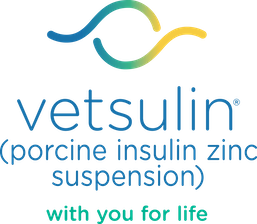

Long-Term Management
Learn More About Dosing & Administration
Stabilizing Canine Diabetes Long-Term
Help clients understand that their dogs can live healthy, active lives when their dog’s diabetes is properly regulated.
Monitoring
Once the maintenance dose has been established and the dog is stable, a long-term management program must be implemented. The aim is to minimize variations in insulin requirement. This includes monitoring to detect underdosage or overdosage of insulin, and adjustment of dose, if required. Careful monitoring during maintenance will help limit the chronic problems associated with diabetes.
Various approaches to maintenance have been described. The type of monitoring plan that occurs at home should be established based on owner’s choice. All owners should be instructed to monitor and record the dog’s general health (including thirst, urinations, appetite and general well being). In addition, home glucose monitoring and/or urine sugar monitoring should be recorded, if opted to by the owners. During follow up visits, owner logs and clinical data will be evaluated to establish if insulin dose changes are indicated. Dogs should be checked every 2 to 4 months (more often if there are problems) for general health, urine glucose, and blood glucose level. Adjustments to the insulin dose must be based on full analysis of clinical data and the blood glucose measurement.
Other Health Factors
The use of progestogens in dogs suffering from diabetes mellitus should be avoided. Ovariohysterectomy should be recommended for intact bitches. Stress and irregular exercise must be avoided. Care must be taken with the use of corticosteroids. It is important to establish a strict feeding schedule in consultation with the owner that will include a minimum of fluctuations and changes.
Clinical Signs
It is extremely important that owners are able to recognize the signs of hypo- or hyperglycemia and respond appropriately. Polyuria, polydipsia, and polyphagia in combination with weight loss, general bad condition, loss of hair or abnormal furry coat, and lethargy are the most common clinical signs of hyperglycemia and require administration of insulin to restore blood glucose levels to an acceptable range.
However, these clinical signs may also be present due to a rebound hyperglycemia secondary to a hypoglycemic episode (Somogyi overswing). While a blood glucose curve can help differentiate between insufficient insulin dosing and Somogyi overswing, the results can be confusing if the rebound hyperglycemia persists for a few days. Evaluating weight changes in the patient can help shed some light. If the dog is losing weight and exhibiting clinical signs of diabetes mellitus, the insulin dose may be insufficient. If the dog is gaining or maintaining weight but continues to have clinical signs consistent with diabetes mellitus, the insulin dose may be excessive, and causing Somogyi overswing.
The clinical signs of hypoglycemia, in increasing order of severity, are:
- Very quiet and inappetent
- Hunger
- Restlessness
- Shivering
- Ataxia
- Disorientation
- Convulsions and coma
If these signs are observed, owner should contact the veterinarian. Owners of pets with diabetes should always have a source of glucose readily available. Following the successful emergency administration of oral glucose, small amounts of food should be offered at intervals of 1–2 hours until the effects of the insulin overdose have been counteracted.
Help Your Practice Manage Diabetes Mellitus
View and download resources and tools that will assist your hospital, inform your team, and help with clients.

Blood Glucose Curve Generator
Create a blood glucose curve to monitor and evaluate diabetes treatments.

Client Discharge Form
Create a customized, printable form for clients about their new diagnosis.

Diabetes Resources
Access online tools and more to support staff and pet parents.
No items to show.
Learn More About Dosing & Administration
Important Safety Information:
Vetsulin® should not be used in dogs known to have a systemic allergy to pork or pork products. Vetsulin is contraindicated during periods of hypoglycemia. Keep out of reach of children. As with all insulin products, careful patient monitoring for hypoglycemia and hyperglycemia is essential to attain and maintain adequate glycemic control and prevent associated complications. Overdosage can result in profound hypoglycemia and death. The safety and effectiveness of Vetsulin in puppies, breeding, pregnant, and lactating dogs has not been evaluated. See package insert for full information regarding contraindications, warnings, and precautions.
References:
1. Martin GJ, Rand JS. Pharmacology of a 40 IU/ml porcine lente insulin preparation in diabetic cats: findings during the first week and after 5 or 9 weeks of therapy. J Feline Med Surg. 2001;3(1):23–30. 2. Vetsulin® (porcine insulin zinc suspension) [Freedom of Information Summary]. Millsboro, DE: Intervet Inc.; 2008. 3. Data on file, Merck Animal Health. 4. Graham PA, Nash AS, McKellar QA. Pharmacokinetics of porcine insulin zinc suspension in diabetic dogs. J Small Anim Pract. 1997;38(10):434–438. 5. Martin GJ, Rand JS. Pharmacokinetic and Pharmacodynamic Study of Caninsulin in Cats with Diabetes Mellitus. 2000: Internal Study Report. 6. Feldman EC, Nelson RW. Canine and Feline Endocrinology and Reproduction. 3rd ed. St. Louis, MO: Saunders; 2004:539–579. 7. Tennant B, ed. BSAVA Small Animal Formulary. 4th ed. Gloucestershire, UK: British Small Animal Veterinary Association; 2002. 8. Feldman EC, Nelson RW. Canine and Feline Endocrinology and Reproduction. 3rd ed. St. Louis, MO: Saunders; 2004:486–538. 9. Reusch C. Feline diabetes mellitus. In: Ettinger SJ, Feldman EC, eds. Textbook of Veterinary Internal Medicine. 7th ed. St. Louis, MO: Saunders; 2010:1796–1816. 10. Nelson RW. Canine diabetes mellitus. In: Ettinger SJ, Feldman EC, eds. Textbook of Veterinary Internal Medicine. 7th ed. St. Louis, MO: Saunders; 2010:1782–1796. 11. Burgaud S, Riant S, Piau N. Comparative laboratory evaluation of dose delivery using a veterinary insulin pen. In: Proceedings of the WSAVA/FECAVA/BSAVA congress; 12–15 April 2012; Birmingham, UK. Abstract 121. 12. Burgaud S, Guillot R, Harnois-Milon G. Clinical evaluation of a veterinary insulin pen in diabetic dogs. In: Proceedings of the WSAVA/ FECAVA/BSAVA congress; 12–15 April 2012; Birmingham, UK. Abstract 122. 13. Burgaud S, Guillot R, Harnois-Milon G. Clinical evaluation of a veterinary insulin pen in diabetic cats. In: Proceedings of the WSAVA/FECAVA/BSAVA congress; 12–15 April 2012; Birmingham, UK. Abstract 45. 14. Davison LJ, Walding B, Herrtage ME, Catchpole B. Anti-insulin antibodies in diabetic dogs before and after treatment with different insulin preparations. J Vet Intern Med. 2008;22:1317-1325. 15. Banfield State of Pet Health 2016 Report. p 12-13.
